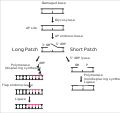Base excision repair
Base excision repair (BER) is a cellular process that corrects DNA damage caused by oxidation, deamination, or alkylation. These types of damage can lead to changes in the structure of the DNA molecule, potentially leading to mutations and genetic diseases.
Mechanism[edit]
The process of base excision repair involves several steps. First, a DNA glycosylase enzyme recognizes and removes the damaged base, leaving behind an apurinic/apyrimidinic site (AP site). This is followed by the action of an AP endonuclease, which cleaves the phosphodiester bond in the DNA backbone at the AP site. The resulting gap is then filled in by a DNA polymerase, which adds the correct nucleotide, and a DNA ligase, which seals the nick in the DNA backbone.
There are two sub-pathways of BER: short-patch BER, which replaces a single nucleotide, and long-patch BER, which replaces 2-10 nucleotides.
DNA glycosylases[edit]
DNA glycosylases are a family of enzymes involved in base excision repair. They are responsible for identifying and removing the damaged base, initiating the repair process. There are several different types of DNA glycosylases, each of which recognizes and removes a specific type of damaged base.
AP endonucleases[edit]
AP endonucleases are enzymes that recognize and cleave the DNA backbone at the AP site left by the action of a DNA glycosylase. This creates a gap in the DNA molecule that can be filled in by a DNA polymerase.
DNA polymerases[edit]
DNA polymerases are enzymes that synthesize new DNA molecules by copying a DNA template strand. In the context of base excision repair, a DNA polymerase fills in the gap left by the action of an AP endonuclease, adding the correct nucleotide to replace the damaged base.
DNA ligases[edit]
DNA ligases are enzymes that join two DNA strands together by forming a phosphodiester bond. In the context of base excision repair, a DNA ligase seals the nick in the DNA backbone after the correct nucleotide has been added by a DNA polymerase.
Clinical significance[edit]
Defects in base excision repair can lead to an increased risk of cancer, as DNA damage that is not properly repaired can lead to mutations. In addition, certain neurological disorders and aging-related diseases have been linked to defects in base excision repair.
| DNA repair | ||||||||||
|---|---|---|---|---|---|---|---|---|---|---|
* Category
|

This article is a cell biology stub. You can help WikiMD by expanding it!
-
BER basic pathway
-
8-oxoG forming Hoogsteen base pair with dA
-
Uracil base glycosidase
-
Desaminierung C to U
-
Demethylation of 5-methylcytosine
Ad. Transform your life with W8MD's Budget GLP-1 injections from $75


W8MD offers a medical weight loss program to lose weight in Philadelphia. Our physician-supervised medical weight loss provides:
- Weight loss injections in NYC (generic and brand names):
- Zepbound / Mounjaro, Wegovy / Ozempic, Saxenda
- Most insurances accepted or discounted self-pay rates. We will obtain insurance prior authorizations if needed.
- Generic GLP1 weight loss injections from $75 for the starting dose.
- Also offer prescription weight loss medications including Phentermine, Qsymia, Diethylpropion, Contrave etc.
NYC weight loss doctor appointmentsNYC weight loss doctor appointments
Start your NYC weight loss journey today at our NYC medical weight loss and Philadelphia medical weight loss clinics.
- Call 718-946-5500 to lose weight in NYC or for medical weight loss in Philadelphia 215-676-2334.
- Tags:NYC medical weight loss, Philadelphia lose weight Zepbound NYC, Budget GLP1 weight loss injections, Wegovy Philadelphia, Wegovy NYC, Philadelphia medical weight loss, Brookly weight loss and Wegovy NYC
|
WikiMD's Wellness Encyclopedia |
| Let Food Be Thy Medicine Medicine Thy Food - Hippocrates |
Medical Disclaimer: WikiMD is not a substitute for professional medical advice. The information on WikiMD is provided as an information resource only, may be incorrect, outdated or misleading, and is not to be used or relied on for any diagnostic or treatment purposes. Please consult your health care provider before making any healthcare decisions or for guidance about a specific medical condition. WikiMD expressly disclaims responsibility, and shall have no liability, for any damages, loss, injury, or liability whatsoever suffered as a result of your reliance on the information contained in this site. By visiting this site you agree to the foregoing terms and conditions, which may from time to time be changed or supplemented by WikiMD. If you do not agree to the foregoing terms and conditions, you should not enter or use this site. See full disclaimer.
Credits:Most images are courtesy of Wikimedia commons, and templates, categories Wikipedia, licensed under CC BY SA or similar.
Translate this page: - East Asian
中文,
日本,
한국어,
South Asian
हिन्दी,
தமிழ்,
తెలుగు,
Urdu,
ಕನ್ನಡ,
Southeast Asian
Indonesian,
Vietnamese,
Thai,
မြန်မာဘာသာ,
বাংলা
European
español,
Deutsch,
français,
Greek,
português do Brasil,
polski,
română,
русский,
Nederlands,
norsk,
svenska,
suomi,
Italian
Middle Eastern & African
عربى,
Turkish,
Persian,
Hebrew,
Afrikaans,
isiZulu,
Kiswahili,
Other
Bulgarian,
Hungarian,
Czech,
Swedish,
മലയാളം,
मराठी,
ਪੰਜਾਬੀ,
ગુજરાતી,
Portuguese,
Ukrainian




